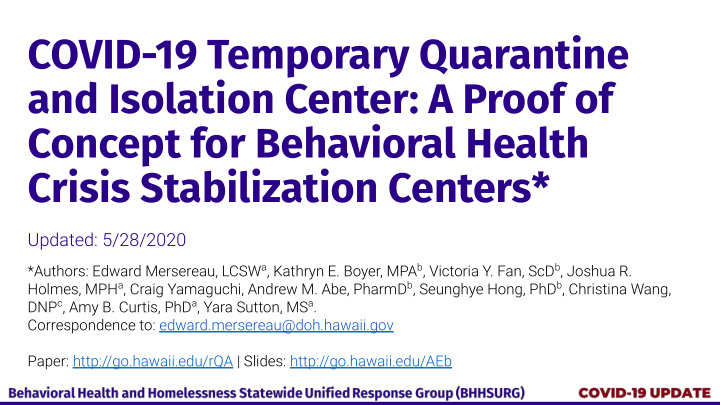



COVID-19 Temporary Quarantine and Isolation Center: A Proof of Concept for Behavioral Health Crisis Stabilization Centers* Updated: 5/28/2020 *Authors: Edward Mersereau, LCSW a , Kathryn E. Boyer, MPA b , Victoria Y. Fan, ScD b , Joshua R. Holmes, MPH a , Craig Yamaguchi, Andrew M. Abe, PharmD b , Seunghye Hong, PhD b , Christina Wang, DNP c , Amy B. Curtis, PhD a , Yara Sutton, MS a . Correspondence to: edward.mersereau@doh.hawaii.gov Paper: http://go.hawaii.edu/rQA | Slides: http://go.hawaii.edu/AEb
Temporary Quarantine and Isolation Center (TQIC) The COVID-19 pandemic became an urgent impetus for establishing the TQIC for homeless individuals. • Using a facility offered in partnership by the City & County of Honolulu , the Hawai ʻ i Department of Health Behavioral Health Administration has operated the TQIC with other partners. • In the present system of care for behavioral health, many clients are not severe enough for psychiatric inpatient care but too severe for residential options. • The TQIC demonstrates proof of concept of the Behavioral Health Crisis Stabilization Center providing services for several clients in a short period who were, in turn, connected with and placed into more stable long-term services.
In the absence of a Behavioral Health Crisis Stabilization Center The State will continue to burden: 1. Avoidable hospital costs and utilization for hospital-based care for emergency department visits and inpatient stays. 2. A high volume of high-need individuals passed between an overburdened criminal justice system (courts, correctional facilities). 3. A high volume of homeless unsheltered individuals at large in the community without receiving the necessary services.
The Continuum of Care for Behavioral Health The Hawai ʻ i State Department of Health (HDOH)’s Behavioral Health Administration (BHA) is the only statutory entity in the State that coordinates a comprehensive behavioral health system and is also a payer of healthcare services. Services BHA provides across continuum of care: 1. Crisis Services 2. Limited Stabilization Services 3. Treatment Services 4. Preventive, Reintegration, Transition, and Care Coordination Services
Goldilocks Problem: No Behavioral Health Crisis Stabilization Center in the State Some individuals face a ‘Goldilocks’ problem of needing care that is too low for inpatient care and too high for Licensed Crisis Residential Service, but rather a middle level of stabilization that could be offered through a Behavioral Health Crisis Stabilization Center. Without such an option, individuals resort to the ED, resulting in significant costs to public payers .
The High Societal Cost of an ED-Centric Approach ● Homeless populations with behavioral and physical health needs are particularly vulnerable and costly to treat . ● Average number of inpatient and outpatient stays per unique client was 1.4 and 1.6, respectively, indicating that clients presenting for acute psychiatric care are repeat visitors . ● The current ED-centric approach for psychiatric patients is likely low value for money and imposes high societal as well as medical costs .
A Nationally Recommended Cost-Saving Approach ● Establishing a Behavioral Health Crisis Stabilization Center in the State is a major strategic priority of BHA. ● Provide cost savings through reduced psychiatric hospitalization , while maintaining the same standard of outcomes. ● SAMHSA has noted that, in the continuum of services for psychiatric emergencies, crisis stabilization and 23-hour observation beds should be utilized as alternatives to costly inpatient hospitalizations.
Filling a Crucial Gap in Care Crisis Stabilization Centers serve as a crucial intermediary for clients who need more than routine outpatient care, but do not need inpatient hospitalization services. Such Centers can address needs of patients not currently met by Acute Psychiatric Hospital Care or Emergency Department visits, Non-acute Residential Treatment, or by Home or Mobile services.
Other States Have Implemented Crisis Stabilization Centers Oregon : Established a Washington : Alaska : Implemented San Francisco : new $40M center Will construct a the Acute Behavioral Established a facility dedicated psychiatric new 32-bed Health Care with 100 beds for emergency room, the behavioral Improvement Project specifically serving Unity Center for health facility with the goals of individuals suffering Behavioral Health in for Mental decreasing avoidable ED from addiction and partnership with Oregon Health Crisis visits and repeated ED mental illness that Health State University, Stabilization in revisits for individuals integrates Kaiser Permanente, Spokane with behavioral health homelessness and Adventist Health, and (March 30, issues who present to behavioral health Legacy Health (January 2020). the ED (August 6, 2019). (February 21, 2019). 6, 2017).
The Return on Investment Behavioral Health Crisis Stabilization Services have been shown to decrease total cost of care when compared to strategies focusing predominantly on acute psychiatric hospitalizations
Overview of TQIC ● HDOH operates the TQIC to provide care to unsheltered people under investigation (PUI) for COVID-19 ● The TQIC provides 24-hour medical staffing and case management services for these clients with a multitude of physical and behavioral health needs. ● Each client admitted to the TQIC is assigned a case manager through the Institute for Human Services (IHS) onsite case management team ○ The Behavioral Health and Homelessness Statewide Unified Response Group (BHHSURG) website (http://bhhsurg.hawaii.gov) has more information on intake procedures and clinical decision trees.
TQIC Client Profile As of 5/18/2020, 51 individuals have been admitted and treated at the TQIC.
Other Chronic and Acute Conditions All 51 clients who entered the TQIC were provided extensive medical services to address all of the unique conditions they presented with.
TQIC Outcomes
Recommend
More recommend